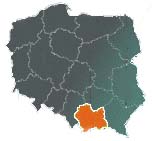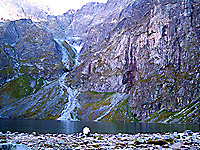|

Malopolskie
Voivodeship - the region around
Krakow
Malopolska is one of Poland’s 16 administrative provinces (wojewodztwo),
with Krakow as the capital city, and comprises 8.3% of the
country’s population. It has its own provincial parliament
and the executive, albeit both with limited powers.
The Malopolska province makes up the chief part of Poland’s
larger historical region of Malopolska bordering on the
Ukraine to the east and Slovakia to the south, and on the
Polish regions of Slask to the west and Mazowsze to the
north. It is an area of charming beauty, with copious
medieval towns and castles dotting the hillsides and the
Carpathian Mountains covered with lush vegetation. A perfect
place for those fond of diverse scenery with great walks,
hikes, skiing, biking, fishing, camping out in the open,
etc.
Geography
The Malopolska province is placed right in the center
of Europe and makes Poland’s south. The region takes up the
upper Vistula river basin. Half of the province lies 500 m or
more above sea level, including the highest Polish peak, Rysy
(2499 m), in the scenic Alps-like range of the
Tatra mountains.

Tatry Mountains. Czarny Staw (Black Pond), the
austere sister lake of the nearby gorgeous Morskie Oko.
Economy
Services flourish, industry carries on, and agriculture
lingers on in the Malopolska province. Five universal banks have
their headquarters here (namely in Krakow) in addition to over
100 local cooperative banks. Further 25 big banks operate in the
province via their branches, outposts of multinational giants as
Deutsche and Citicorp in that number.
Some 246,000 industrial jobs account for 26.5% of the
province’s total, with metals, steel, machinery, chemicals,
tobacco and wearable goods being the staples. Among others,
the Malopolska province is home to Europe's fourth biggest
maker of cables (Krakow's Tele-Fonika), Europe's third
largest producer of synthetic rubber (Oswiecim's Dwory), and
the world's second biggest maker of roof windows (Nowy
Sacz's Fakro).
The high-tech gets high profile by day in the Malopolska
province that already boasts Poland’s biggest computer maker,
most-visited internet portal and largest fiberglass cable
producer as well as Motorola’s European R&D center. Besides the
local media Malopolska is home to the nation’s most popular
radio network and the biggest regional TV station. It has one
special economic zone (Krakow Technological Park, meant for
major high-tech investments), 4 enterprise incubators, 3
commercial-fair grounds, 8 higher economics schools.
Malopolska's accounts for 5.5 percent of Poland's exports.
In 2003 the province's businesses sold abroad goods worth
over 2.6 billion euros (or 808 euros per capita). Machines
made up 30.4 percent of of the exports value, steel and
other metal products 16.4 percent, plastics 7.3 percent,
motor industry 6.5 percent, chemicals 6.2 percent, foods 5.7
percent, and paper 4.7 percent. The European Union accounted
for 60.6 percent of the Malopolska exports with Germany as
the main importing nation with its 27.8-percent share, while
combined Eastern Europe bought 29 percent.
Over 857,000 ha of arable land takes up 56.6% of the provinces
territory divided among 222,500 farms–average 3.2 ha per farm.
Foreign Direct Investment
The Malopolska province is the fourth most popular
destination of FDI among Poland’s regions in absolute terms.
Over 70% of its $1.5 billion intake went to Krakow. Germans were
investing in the Malopolska province most often, yet Americans
outspent everybody. Major investors proved Germany’s Hypo-Vereinsbank
and Deutsche Bank 24 (banking), US Philip Morris (tobacco),
Croatia’s Pliva (pharmaceuticals), France’s Electricite de
France (power generation), Coca Cola (beverages), Turkey’s
Rumeli (cement) and Denmark’s Carlsberg (beer).
Foreign-controlled companies provide some 45,000 jobs, about
8,000 newly created.
Transport
Krakow’s Balice International Airport is Poland’s second
biggest. There are 1002 km of national, 1540 km of provincial,
and 6483 km of county roads in the Malopolska province. Four
border passages lead abroad, to Slovakia and farther south to
Austria, Hungary, France, Italy, Switzerland, the Balkans, and
so on. The province is also crisscrossed with 997 km of railway
lines, and has a cross-border rail passage.
Tourism
The Malopolska province embodies Polish prime tourist
destinations, be it summer or winter. There are such obvious
musts as Krakow, Tatra Mountains, Auschwitz, Wieliczka or Jura. At the
same time the best hiking, skiing, bird-watching, biking, water
sports, fishing, sightseeing, etc. can be found in the region.
And the Malopolska’s abundant mineral-water and thermal springs
together with bracing climate gave rise to many health resorts.
Also agrotourism (i.e. tasting peasant life in comfort) proves
ever more popular. Plus colorful and varied folklore.

The old larch church in the resort
town of Rabka,
Wildlife
The Malopolska province boasts more wildlife sanctuaries
than any region in Poland. Its six
national parks
– Gorce Park, Babia Gora Park, Ojcow Park, Pieniny Park, Tatra
Park and Magura Park– cover 37,678 hectares, i.e. 2.5% of the
province’s territory. Additional 2,300 ha form 80 wildlife
reserves, while 157,000 ha make up 10 landscape parks. And some
650,000 ha rank as the protected landscape areas, which amounts
to 42.5% of the Malopolska province. Woods cover 432,000 ha,
i.e. 28.5% of the province, of which about 210,000 ha are
protected forests.
Numbers
Area: 15,144 sq. km, 22 counties (3 municipal), 182
communes, 52 cities (25 under 10,000 and just one, Krakow, above
500,000), 2,635 villages.
Population: 3,2 million, 212,4 per sq. km, growth 0.23% a year,
58.6% school age and younger, 14.3% elderly, 50.6% urban.
Unemployment: 6 percent of the workforce in May 2017 (3.3
percent in
the city of Krakow).
Infrastructure: 9,025 km of roads, 997 km of railway lines, 18,5
phone lines per 100 inhabitants, 85,500 beds in 86 hotels and
2,300 other lodgings (1999), 886,155 apartments with 56,071,490
sq. meters of floor space.
Health: 45 hospitals with 17,235 beds, 67,200 spa patients a
year in 66 sanatoriums.
Higher Education: Over 150,000 students of nearly thirty universities.
|

Poland
In the proximity
of Krakow
Krakow is Poland's tourist mecca, and also a gateway to
many other must-see sites in the region.
Biggest Corporations in the Malopolska Province
Polish National Parks in Malopolska province
Malopolska
Province map
Poland map
City of Krakow map
Health resorts in the Malopolska region
Krakow
Poland's prime tourist attraction and a must in Central
Europe boasts numerous world-class monuments, charming vistas,
delightful atmosphere, and the best restaurants.
Good hotels in Krakow
Best restaurants of Krakow
Krakow geography
Krakow politics
Krakow economy
Krakow history
Krakow environment
Krakow wildlife
|
